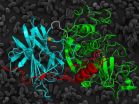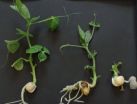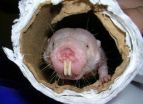(Press-News.org) DURHAM, N.C. -- Under the right scenario, exporting U.S. coal to power plants in South Korea could lead to a 21 percent drop in greenhouse gas emissions compared to burning the fossil fuel at plants in the United States, according to a new Duke University-led study.
"Despite the large amount of emissions produced by shipping the coal such a long distance, our analysis shows that the total emissions would drop because of the superior energy efficiency of South Korea's newer coal-fired power plants," said Dalia Patiño-Echeverri, assistant professor of energy systems and public policy at Duke.
For the reduction to occur, U.S. plants would need to replace the exported coal with natural gas. And in South Korea, the imported coal must replace other coal as the power source. However, if imported U.S. coal were to replace natural gas or nuclear generation in Korea, the emissions produced per unit of electricity generated would increase, Patiño-Echeverri said.
"This significant difference in results highlights the importance of analyzing domestic energy policies in the context of the global systems they affect," Patiño-Echeverri said.
Stricter emissions requirements on coal-fired power plants, together with low natural gas prices, have contributed to a recent decline in the use of coal for electricity generation in the United States, she said. Faced with a shrinking domestic market, many coal companies are taking advantage of a growing export market. U.S. coal exports hit an all-time high in 2012, fueled largely by demand in Asia. U.S. coal exports to Asian countries have tripled since 2009.
Patiño-Echeverri and her colleagues published their findings this month in the peer-reviewed journal Environmental Science & Technology.
To conduct their analysis, they performed lifecycle air-emissions and economic assessments of two scenarios: a business-as-usual scenario in which the coal continues to be burned domestically for power generation at power plants in the U.S. Northwest after they have been retrofitted to meet EPA emissions standards, and an export scenario in which the coal is shipped to South Korea. For the export scenario, they focused on the Morrow Pacific Project being planned in Oregon by Ambre Energy. Under the project, Ambre would ship 8.8 million tons of Powder River Basin coal each year to Asian markets using rails, river barges and ocean vessels.
In the export scenario, emissions of "equivalent carbon dioxide" -- a scientific measure of the coal emissions' total global warming potential over a 100-year period -- dropped 21 percent.
Other harmful emissions, including sulfur dioxide, nitrogen oxide and particulate matter, dropped similarly.
"In addition to these benefits, our analysis shows that the export scenario would generate more than $25 billion in direct and indirect economic activity in the United States," Patiño-Echeverri said. "It would also directly or indirectly create nearly $6 billion in total employee compensation, $742 million in new tax revenues, and roughly $4.7 billion in profits for all sectors involved."
Promising though these results are, "it's too early to give the export scenario an unequivocal green light," she said.
Further studies are needed to assess the export scenario's full environmental impacts, including water use, land use, the loss or degradation of vital fish and wildlife habitats, and risks associated with extraction and wastewater disposal of U.S. shale gas deposits. And there's still some fine tuning to do on the economic end.
Patiño-Echeverri said the team's projections are limited in precision due to the fact that the Morrow Pacific Project is in a permitting stage, and many of its operational and financial details are still unknown. As more specific information about the project is released, calculations can be updated to present a clearer picture of the impacts the project may have on the U.S. energy system and global environmental conditions.
"It's important to note that this is just one scenario. The export of coal to different markets, under different conditions, might yield very different results," Patiño-Echeverri said. "Our work does not provide a carte blanche for all energy export projects, but it does give us a framework for comparing their impacts and making smarter economic and environmental policy decisions."
Support for the study came from the Center for Climate and Energy Decision Making (SES-0949710), which is funded by the National Science Foundation.
Patiño-Echeverri is Gendell Assistant Professor of Energy Systems and Public Policy at Duke's Nicholas School of the Environment.
She conducted the study with Barrett Bohnengel, a 2013 master's degree graduate of both Duke and the University of North Carolina at Chapel Hill, and Joule Bergerson, assistant professor of chemical and petroleum engineering at the University of Calgary.
INFORMATION:
CITATION: "Environmental Implications of United States Coal Exports: A comparative Life Cycle Assessment of Future Power System Scenarios," by Barrett Bohnengel, Dalia Patiño-Echeverri and Joule Bergerson. Environmental Science & Technology, July 15, 2014. http://pubs.acs.org/doi/abs/10.1021/es5015828
Exporting US coal to Asia could drop emissions 21 percent
Superior energy efficiency of South Korean plants, and choice of replacement fuels in US, are key to success
2014-08-19
ELSE PRESS RELEASES FROM THIS DATE:
The difficult question of Clostridium difficile
2014-08-19
The bacterium Clostridium difficile causes antibiotic-related diarrhoea and is a growing problem in the hospital environment and elsewhere in the community. Understanding how the microbe colonises the human gut when other "healthy" microbes have been destroyed during a course of antibiotics might lead to new ways to control infection. An important clue was reported recently in an open access article published in the journal Acta Crystallographica Section D Biological Crystallography. [Bradshaw et al. (2014). Acta Cryst. D70, 1983-1993; doi:10.1107/S1399004714009997]
Ravi ...
Zebrafish help to unravel Alzheimer's disease
2014-08-19
New fundamental knowledge about the regulation of stem cells in the nerve tissue of zebrafish embryos results in surprising insights into neurodegenerative disease processes in the human brain. A new study by scientists at VIB and KU Leuven identifies the molecules responsible for this process.
Zebrafish as a model
The zebrafish is a small fish measuring 3 to 5 cm in length, with dark stripes along the length of its body. They are originally from India, but also a popular aquarium fish. Zebrafish have several unusual characteristics that make them popular for scientific ...
Why global warming is taking a break
2014-08-19
Global warming is currently taking a break: whereas global temperatures rose drastically into the late 1990s, the global average temperature has risen only slightly since 1998 – surprising, considering scientific climate models predicted considerable warming due to rising greenhouse gas emissions. Climate sceptics used this apparent contradiction to question climate change per se – or at least the harm potential caused by greenhouse gases – as well as the validity of the climate models. Meanwhile, the majority of climate researchers continued to emphasise that the short-term ...
Has the puzzle of rapid climate change in the last ice age been solved?
2014-08-19
During the last ice age a large part of North America was covered with a massive ice sheet up to 3km thick. The water stored in this ice sheet is part of the reason why the sea level was then about 120 meters lower than today. Young Chinese scientist Xu Zhang, lead author of the study who undertook his PhD at the Alfred Wegener Institute, explains. "The rapid climate changes known in the scientific world as Dansgaard-Oeschger events were limited to a period of time from 110,000 to 23,000 years before present. The abrupt climate changes did not take place at the extreme ...
How steroid hormones enable plants to grow
2014-08-19
Plants are superior to humans and animals in a number of ways. They have an impressive ability to regenerate, which enables them to regrow entire organs. After being struck by lightning, for example, a tree can grow back its entire crown. But there is one major downside to life as a plant: They are quite literally rooted to the habitats in which they live and therefore completely at the mercy of the elements. In response to this dilemma, plants have developed mechanisms that enable them to rapidly adapt their growth and development to changes.
Plant hormones are important ...
First indirect evidence of so-far undetected strange baryons
2014-08-19
UPTON, NY-New supercomputing calculations provide the first evidence that particles predicted by the theory of quark-gluon interactions but never before observed are being produced in heavy-ion collisions at the Relativistic Heavy Ion Collider (RHIC), a facility that is dedicated to studying nuclear physics. These heavy strange baryons, containing at least one strange quark, still cannot be observed directly, but instead make their presence known by lowering the temperature at which other strange baryons "freeze out" from the quark-gluon plasma (QGP) discovered and created ...
Hope for healthy hearts revealed in naked mole rat studies
2014-08-19
SAN ANTONIO (Aug. 14, 2014) — Cardiovascular disease is the greatest killer of humans the world over, presenting huge financial and quality-of-life issues. It is well known that the heart becomes less efficient with age in all mammals studied to date, even in the absence of overt cardiac disease. However, scientists still don't have a good understanding of how to prevent these functional declines that ultimately may lead to debilitating cardiovascular disease.
The longest-lived rodent, the naked mole rat, beats these odds and escapes cardiovascular aging, at least to ...
Men fare worse than women in China regarding discrimination among obese workers
2014-08-19
New research that analyzes economic disparity among obese Chinese adults shows that there is no wage disparity for obese women in China, but there is pay inequality among obese men.
Women in China make less on average than men, but the study results showed no disparity in wages because of body weight. Results of the study for men showed increasing wage disparities by occupation when gaining weight.
The study, "The Obesity Pay Gap: Gender, Body Size, and Wage Inequalities: A Longitudinal Study of Chinese Adults, 1991-2009," which will be presented at the 109th Annual ...
Purdue ag economists: Shale oil 'dividend' could pay for smaller carbon footprint
2014-08-19
WEST LAFAYETTE, Ind. - Unanticipated economic benefits from the shale oil and gas boom could help offset the costs of substantially reducing the U.S.'s carbon footprint, Purdue agricultural economists say.
Wally Tyner and Farzad Taheripour estimate that shale technologies annually provide an extra $302 billion to the U.S. economy relative to 2007, a yearly "dividend" that could continue for at least the next two decades, Tyner said.
Using an economic model, they found that "spending" part of this dividend on slashing the nation's carbon emissions by about 27 percent ...
NASA's RXTE satellite decodes the rhythm of an unusual black hole
2014-08-19
Astronomers have uncovered rhythmic pulsations from a rare type of black hole 12 million light-years away by sifting through archival data from NASA's Rossi X-ray Timing Explorer (RXTE) satellite.
The signals have helped astronomers identify an unusual midsize black hole called M82 X-1, which is the brightest X-ray source in a galaxy known as Messier 82. Most black holes formed by dying stars are modestly-sized, measuring up to around 25 times the mass of our sun. And most large galaxies harbor monster, or supermassive, black holes that contain tens of thousands of times ...
LAST 30 PRESS RELEASES:
Brain stimulation device cleared for ADHD in the US is overall safe but ineffective
Scientists discover natural ‘brake’ that could stop harmful inflammation
Tougher solid electrolyte advances long-sought lithium metal batteries
Experts provide policy roadmap to reduce dementia risk
New 3D imaging system could address limitations of MRI, CT and ultrasound
First-in-human drug trial lowers high blood fats
Decades of dredging are pushing the Dutch Western Scheldt Estuary beyond its ecological limits
A view into the innermost workings of life: First scanning electron microscope with nanomanipulator inaugurated in hesse at Goethe University
Simple method can enable early detection and prevention of chronic kidney disease
S-species-stimulated deep reconstruction of ultra-homogeneous CuS nanosheets for efficient HMF electrooxidation
Mechanical and corrosion behavior of additively manufactured NiTi shape memory alloys
New discovery rewrites the rules of antigen presentation
Researchers achieve chain-length control of fatty acid biosynthesis in yeast
Water interactions in molecular sieve catalysis: Framework evolution and reaction modulation
Shark biology breakthrough: Study tracks tiger sharks to Maui mating hub
Mysterious iron ‘bar’ discovered in famous nebula
World-first tool reduces harmful engagement with AI-generated explicit images
Learning about public consensus on climate change does little to boost people’s support for action, study shows
Sylvester Cancer Tip Sheet for January 2026
The Global Ocean Ship-Based Hydrographic Investigations Program (GO-SHIP) receives the Ocean Observing Team Award
Elva Escobar Briones selected for The Oceanography Society Mentoring Award
Why a life-threatening sedative is being prescribed more often for seniors
Findings suggest that certain medications for Type 2 diabetes reduce risk of dementia
UC Riverside scientists win 2025 Buchalter Cosmology Prize
SETI Institute opens call for nominations for the 2026 Tarter Award
Novel theranostic model shows curative potential for gastric and pancreatic tumors
How beige fat keeps blood pressure in check
Fossils reveal ‘latitudinal traps’ that increased extinction risk for marine species
Review: The opportunities and risks of AI in mental health research and care
New map reveals features of Antarctic’s ice-covered landscape
[Press-News.org] Exporting US coal to Asia could drop emissions 21 percentSuperior energy efficiency of South Korean plants, and choice of replacement fuels in US, are key to success




